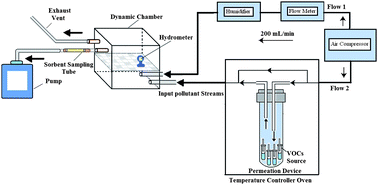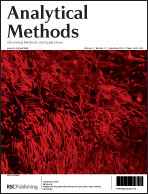Indoor air can become polluted with VOCs, and understanding the factors which affect adsorption of VOCs from indoor air is important for: (i) the accurate measurement of VOCs, and (ii) to apply mitigation strategies when high analyte concentrations are measured. In this study four VOCs (toluene, ethylbenzene, cumene and dichlorobenzene) were generated as a constant and controlled polluted air stream of VOCs from a dynamic atmospheric chamber. The effects of relative humidity, and sampling flow rate, on adsorption onto Tenax TA and the relatively new silica adsorbents SBA-15 or MCM-41 were studied. Air samples were collected and analyzed by thermal desorption followed by GC/MS. All sorbents were shown to be affected by changing the RH conditions from 25 to 80% RH, and sampling flow rates from 25 to 200 cm3 min−1, even when pollutant concentrations and sampled air volumes remained consistent. Although further work is required to examine the effect of the full RH range on scavenging potential, in this study Tenax TA was shown to provide best performance in high RH conditions whereas silica sorbents were more effective at low RH. Moreover it was shown that to provide accurate measurements in the field (e.g., when humidity conditions are fixed) it is suggested that Tenax TA is the preferred sorbent of choice as the masses of VOCs collected were less affected by changing the sampling flow rates.

You have access to this article
 Please wait while we load your content...
Something went wrong. Try again?
Please wait while we load your content...
Something went wrong. Try again?


 Please wait while we load your content...
Please wait while we load your content...